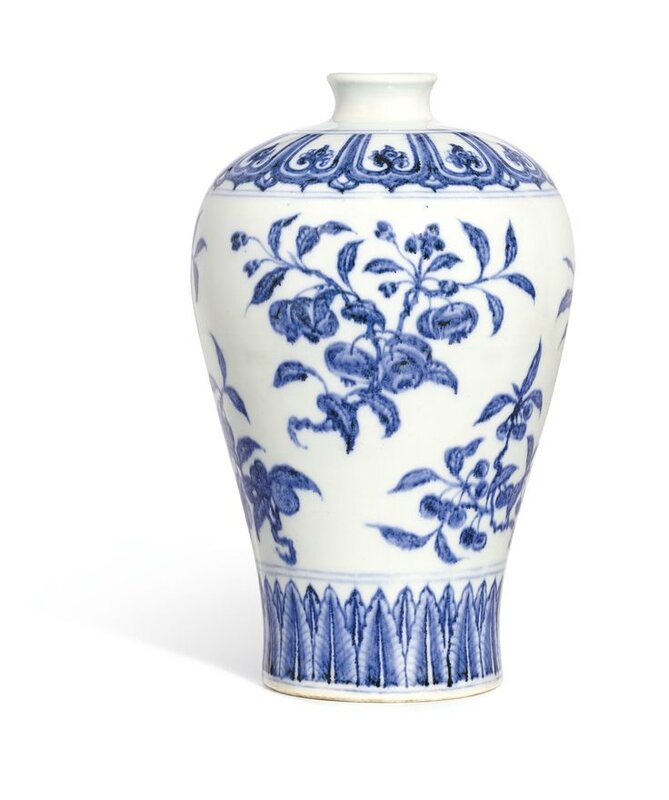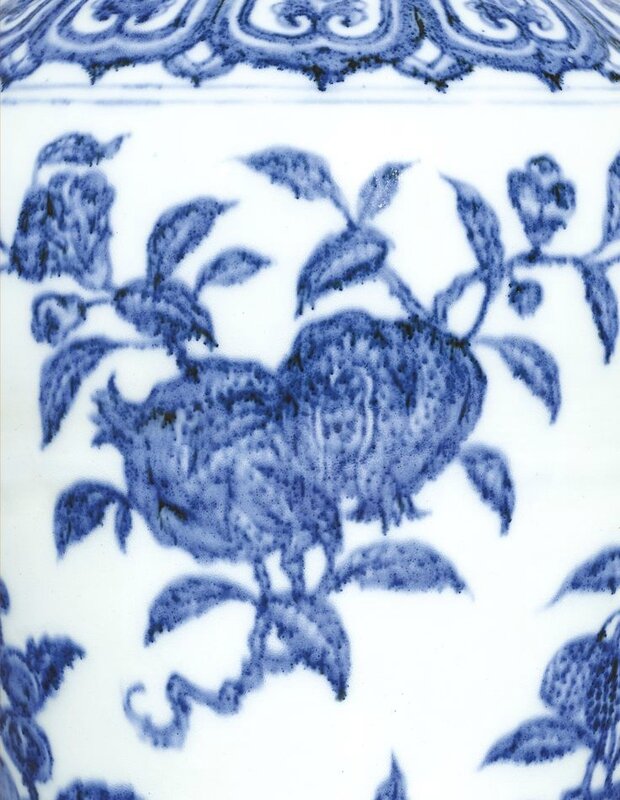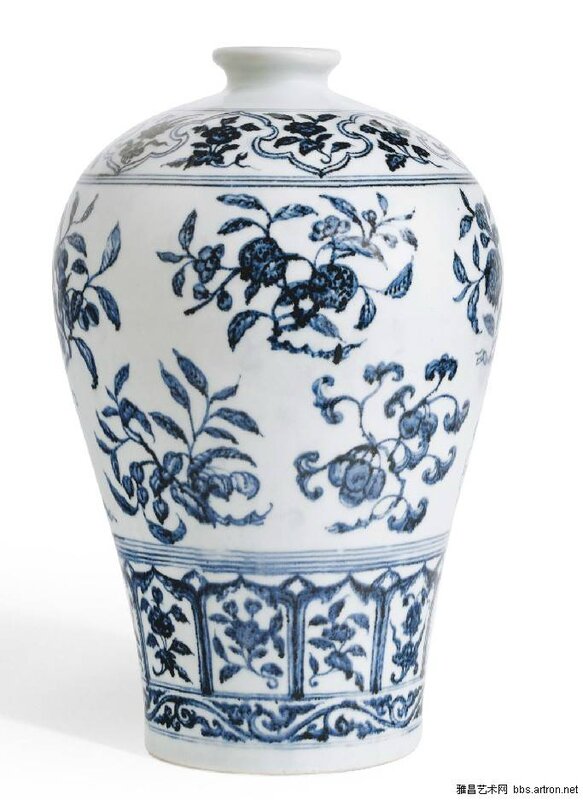A finely painted and rare blue and white 'Fruit' meiping, Ming dynasty, Yongle period
Lot 3607. A finely painted and rare blue and white 'Fruit' meiping, Ming dynasty, Yongle period. Estimate 8,000,000 — 12,000,000 HKD (933,753 - 1,400,630 EUR). Lot sold 10,280,000 HKD. Photo Sotheby's.
with full rounded shoulders rising at a gently flaring angle from the base and sweeping to a short waisted neck, well painted in a lively style in washes of cobalt, the sides with a wide band of six fruit sprays arranged in an alternating double register, the upper register showing detached peach, pomegranate and crab apple, the lower register with lychee, loquat and cherry, the leafy branches further issuing small blossoms and buds, all between double-line borders, the shoulders draped by a band of pendent lotus lappets enclosing elaborate trefoils below the neck, the foot skirted by a band of upright overlapping leaves, the underglaze blue with characteristic 'heaped and piled' effect giving the designs depth and texture, all beneath a slightly blue-tinted transparent glaze, the base left unglazed and later inscribed in ink with partially legible Arabic numbers and English letters; 29 cm., 11 3/8 in.
Provenance: Probably sold in the United Kingdom in the 19th Century (base inscription).
For wine and flowers: Two meiping vases for the Yongle and Qianlong Emperors
Baoping Li
Meiping or ‘prunus vases’ are among the most elegant and interesting vessel shapes of Chinese porcelain. This form, featuring an elongated body and small mouth, was produced in China for about a thousand years, and was greatly favoured by the emperors of the Ming (1368-1644) and Qing (1644-1911) dynasties. Fired in the imperial kilns in Jingdezhen, painted with superb skill with auspicious motifs of lush fruit sprays symbolising wishes for longevity, numerous offspring and the like, the two meiping from the Yongle (1403-24) and Qianlong (1736-1795) periods are amazingly beautiful and extremely rare, and perfectly represent two golden ages of Chinese porcelain. The Qianlong Emperor, one of the greatest collectors and patrons of the arts in China, went to great lengths to have Yongle meiping copied, but to his own taste. In a poem of 1790 about a long-necked vase from the Song dynasty (960-1279), he proclaimed ‘Used to contain wine in ancient times, the vase is now holding flowers, clearly flowers and wine belong to the same family’. The two lines could equally have been written about meiping vases, which underwent the same change of function.
Meiping vases first appeared in the Song period, when they served as the primary type of wine container and were made in great variety by nearly all the famous kilns across China. In contemporary mural paintings they are frequently illustrated in feast scenes. In the Ming dynasty meiping continued to function as wine vessels, but began already to be used for holding flowers. In addition, and more importantly, they also served as ritual vessels and were placed in the tombs of Emperors, princes, aristocrats and high-ranking generals across China. For example, eight large covered meiping with marks of the Jiajing (1522-66) and Wanli (1573-1620) periods have been recovered from the celebrated Dingling mausoleum of the Wanli Emperor near Beijing, of which four came from the Emperor’s funeral chamber and two from those of his two Empresses. The inclusion of meiping of Jiajing mark and period in the Wanli mausoleum documents the significance of these vessels for the Ming emperors. By the Qing dynasty meiping were manufactured primarily as flower vases or display items, as demonstrated in a few paintings, such as one by the court painter Giuseppe Castiglione (1688-1766) (fig. 1). Althoughmeiping were used to hold various kinds of flowers, ‘prunus vase’ became the standard name for this vessel. This may be because the narrow mouth is perfectly suited for holding the slender prunus branches, or perhaps because prunus, due to its winter-resistant beauty, is one of the best-loved flowers in China, symbolising righteous personality sustained even in harsh conditions.
Giuseppe Castiglione, Dragon Boat Festival, hanging scroll, colour on silk, Qing dynasty, Yongzheng period, Collection of Palace Museum, Beijing. After: The Complete Collection of Treasures of the Palace Museum. Paintings by the Court Artists of the Qing Court, Hong Kong, 1996, pl. 22.
In view of this context, the two meiping vases of great beauty are particularly important. The blue-and-white vase represents one of the classic patterns of the Yongle period that illustrates the phenomenal advances made by Jingdezhen’s potters and painters in less than a century, since blue and white porcelain began to be made there. Both in terms of its well-proportioned shape, which was produced with various kinds of decoration, and its lush fruit pattern, one of the most popular motifs of early Ming blue and white which appears equally on other shapes of the period, this design set a standard of excellence that would be emulated for centuries to come. The present piece is remarkable for its particularly fine potting and its tactile glaze, and beautifully displays the characteristic ‘heaping and piling’ of the cobalt-blue painting – a much-copied trademark of imperial blue and white from the early Ming dynasty. The present pattern and in particular this feature were identified with the most desirable Ming porcelain already in the Yongzheng period (1723-1735) of the Qing dynasty.
The Qianlong Emperor commissioned close copies of early Ming porcelains. For example, in the third year of the Qianlong period (1738), the Emperor had a eunuch send two meiping of early Ming to Jingdezhen to be copied by Tang Ying, the greatest porcelain superintendent in Chinese history. One was ‘a Xuande kiln blue-and-white meiping’, the other ‘a Xuande kiln blue-and-white meiping with Three Fruit design’, see Feng Xianming, Annotated Collection of Historical Documents on Ancient Chinese Ceramics, Taipei, 2000, p. 230-232. It was common practice at the Qing court to refer to early Ming blue and white as ‘Xuande (1426-1435) kiln’, which included unmarked pieces from the Yongle kilns. Yongle-style blue and whitemeiping with fruit designs from the Qianlong period are rare; one example in Beijing is included in The Complete Collection of Treasures of the Palace Museum. Blue and White Porcelain with Underglazed Red (III), Shanghai, 2000, pl. 117 (fig. 2).
Blue and white Yongle-style ‘fruits’ meiping, seal mark and period of Qianlong, Collection of Palace Museum, Beijing. After: The Complete Collection of Treasures of the Palace Museum. Blue and White Porcelain with Underglazed Red (III), Shanghai, 2000, pl. 117.
The present Qianlong vase with fruits in underglaze red, however, is even rarer, probably unique, and unusual in several respects. First, this piece differs from common Qianlong meiping in having a narrow shoulder. In fact, the present form is rare amongst meiping vases of the Ming and Qing dynasties, although examples are known, such as a celadon-glazed and a white porcelain vase from the Xuande period, recently illustrated in Wang Guangyao & Jiang Jianxin eds., Imperial Porcelains from the Reign of Xuande in the Ming Dynasty, Palace Museum, Beijing, 2015, cat. nos. 62-63.
Secondly, it is also very rare to find meiping with underglaze-red decoration, which is not surprising, because successful firing of underglaze copper red requires extremely precise control of the firing process in order to achieve a good colour. According to a court record of 1738 about a meiping with dragon design in underglaze red, the Qianlong Emperor deemed the colouring of the copper red not good enough and demanded a better red colour, see Feng Xianming, op. cit., p. 232. The excellent red colour of the present piece is a credit to the kiln master responsible for its successful firing.
Thirdly, it is also extremely rare to find meiping of the Ming and Qing periods with five fruit sprays arranged in two registers like on the present vase, as related Qianlong meiping are usually decorated in underglaze blue with two alternating registers of fruiting and flowering branches, while Yongle examples feature either six or ten fruit sprays in two registers.
During the Yongle period meiping vases were made in the imperial kilns in various sizes with various kinds of decoration, and were equally popular in China as abroad, as examples preserved both in the Chinese palace collections and the Safavid and Ottoman royal collections in Iran and Turkey document.
The present vase is very similar in shape to a pair of Yongle meiping with the famous tianbai or ‘sweet white’ glaze, with covers in underglaze blue, in the celebrated Ataka collection, illustrated in The Beauty of Asian Ceramics: From the Collection of The Museum of Oriental Ceramics, Osaka, Osaka, 2014, pl. 79 (fig. 3). The vases are inscribed in underglaze blue with the characters neifu or ‘Imperial Household’, documenting the significance of meiping vases for the court. For another Yongle white porcelain meiping of different shape also inscribed neifu in blue, now in the Beijing Municipal Institute of Cultural Relics, see Gems of Beijing Cultural Relics Series: Pottery and Porcelain, Beijing, 2004, pl. 160.
Pair of white-glazed meiping with underglaze-blue neifu inscription, Ming dynasty, Yongle period, from the Ataka Collection, collection of the Museum of Oriental Ceramics, Osaka, accession no.: 00704 Courtesy of the Museum of Oriental Ceramics, Osaka.
Several early Ming meiping of similar design and size as the present vase are in the Palace Museum, Beijing, see a Yongle piece illustrated in Zhongguo taoci quanji [Complete series on Chinese ceramics], Shanghai, 1999-2000, vol. 12, pl. 12; another in Geng Baochang, ed., Gugong Bowuyuan cang gu taoci ciliao xuancui [Selection of ancient ceramic material from the Palace Museum], Beijing, 2005, vol. 1, pl. 85 (fig. 4); and a third, attributed to the Xuande period, published in Geng Baochang, ed., Gugong Bowuyuan cang Ming chu qinghua ci [Early Ming blue-and-white porcelain in the Palace Museum], Beijing, 2002, vol. 1, cat. no. 76, together with a Yongzheng copy and the more elaborate Qianlong version of this pattern, vol. 2, cat. nos. 185 and 202.
Blue and white ‘fruit sprays’ meiping, Ming dynasty, Yongle period, Collection of Palace Museum, Beijing. After: Geng Baochang, ed., Gugong Bowuyuan cang gu taoci ciliao xuancui, Beijing, 2005, vol. 1, pl. 85.
Two blue-and-white meiping of this design, one attributed to the Yongle, the other to the Xuande period, are also in the National Palace Museum, Taipei, illustrated in Minji meihin zuroku [Illustrated catalogue of important Ming porcelains], Tokyo, 1977-78, vol. 1, pls. 12 and 39, the two examples slightly varying in proportion, and the latter with the design more tightly arranged, and with a cover.
Another early Ming meiping attributed to the Xuande reign, in the collection of the Shanghai Museum, is illustrated together with a Yongzheng copy in Lu Minghua, Studies of the Shanghai Museum Collections: Ming Imperial Porcelain, Shanghai, 2007, pls. 5-21 and 5-22 (images reversed); and an early Ming example in the Jingdezhen Ceramic Museum is published inKeitokuchin jiki [Jingdezhen ceramics], Kyoto, 1982, pl. 36.
For two similar vases out of a total of six from the Ottoman Royal collection, see Regina Krahl, Chinese Ceramics in the Topkapi Saray Museum, Istanbul, ed. John Ayers, London, 1986, vol. 2, no. 624; and four meiping of this design from the Safavid Royal collection preserved in the Ardabil Shrine in Iran are recorded and one of them illustrated in John Alexander Pope, Chinese Porcelains from the Ardebil Shrine, Washington, D.C., 1956 (rev. ed., London, 1981), pl. 51 top right.
A meiping of this design and similar size from a Nagoya tea ceremony collection was sold in these rooms, 8th April 2014, lot 3023. Another meiping from the Edward T. Chow collection was sold in these rooms, 19th May 1981, lot 409, together with a Qianlong version with fruit and flower sprays, lot 546. A larger Yongle vase from the Estate of Laurance S. Rockefeller was sold in our New York rooms, 21st/22nd September 2005, lot 64.
In shape and decoration all these vessels are closely related to another early Ming meiping design, a more complex variant, which may well represent a prototype of the present pattern, that was slightly simplified to give the individual fruit sprays more prominence. The more complex design shows ten similar fruit sprays distributed over a narrower space and enclosed between more elaborate borders. Five examples of that design are known. Two covered examples are in the Palace Museum, Beijing, illustrated in The Complete Collection of Treasures of the Palace Museum. Blue and White Porcelain with Underglazed Red (I), Shanghai, 2000, pls. 29-30. In addition is a pair with covers excavated at Haidian district, Beijing, both in the Capital Museum, Beijing, one illustrated in Zhongguo taoci quanji [Complete series on Chinese ceramics], Shanghai, 1999-2000, vol. 12, pl. 47, the other in Guang Lin, 'Beijing chutu de jijian Mingdai qinghua ciqi [Some Ming blue and white porcelains excavated in Beijing]', Wenwu 1972, no. 6, pl. 6, fig. 2. The fifth one was sold three times in these rooms, 19th November 1986, lot 209, 2nd November 1998, lot 304, and 5th October 2011, lot 11; illustrated in Sotheby's Hong Kong – Twenty Years, Hong Kong, 1993, pl. 49, again in Sotheby's. Thirty Years in Hong Kong, Hong Kong, 2003, pl. 210, and in Regina Krahl, Chinese Ceramics from the Meiyintang Collection, London, 1994-2010, vol. 4, no. 1641 (fig. 5).
Blue and white ‘fruit sprays’ meiping, Ming dynasty, Yongle period, from the Meiyintang Collection Sotheby’s Hong Kong, 5th October 2011, lot 11.
Sotheby's. Important Chinese Art, Hong Kong, 07 oct. 2015, 02:30 PM

/https%3A%2F%2Fprofilepics.canalblog.com%2Fprofilepics%2F1%2F0%2F100183.jpg)
/https%3A%2F%2Fstorage.canalblog.com%2F03%2F02%2F119589%2F96711876_o.jpg)
/https%3A%2F%2Fstorage.canalblog.com%2F11%2F31%2F119589%2F94773502_o.jpg)
/https%3A%2F%2Fstorage.canalblog.com%2F20%2F83%2F119589%2F94772815_o.jpg)
/https%3A%2F%2Fstorage.canalblog.com%2F26%2F72%2F119589%2F75604929_o.jpg)
/https%3A%2F%2Fstorage.canalblog.com%2F59%2F60%2F119589%2F26458628_o.jpg)











/image%2F1371349%2F20240416%2Fob_2a8420_437713933-1652609748842371-16764302136.jpg)
/image%2F1371349%2F20240414%2Fob_83ee65_2024-nyr-22642-0954-000-a-blue-and-whi.jpg)
/image%2F1371349%2F20240414%2Fob_15808c_2024-nyr-22642-0953-000-a-blue-and-whi.jpg)
/image%2F1371349%2F20240414%2Fob_e54295_2024-nyr-22642-0952-000-a-rare-blue-an.jpg)